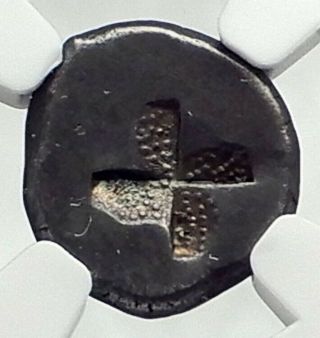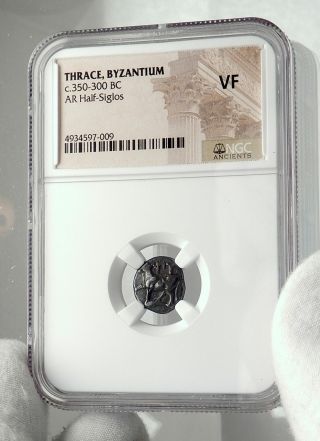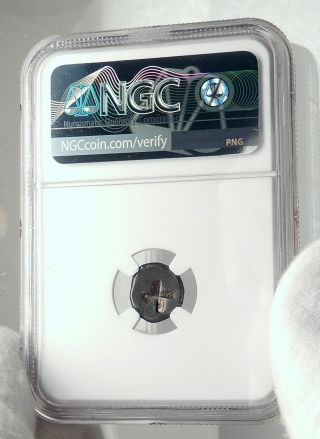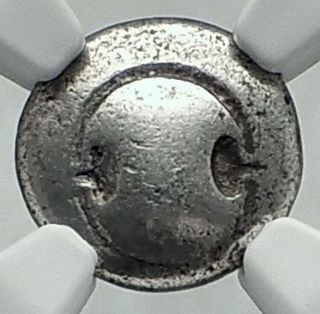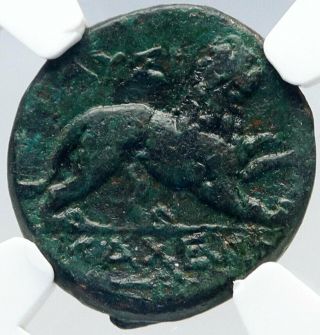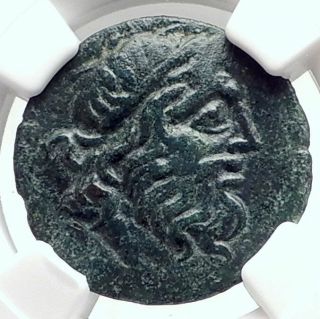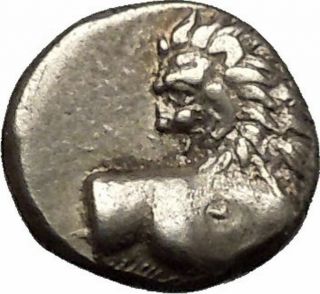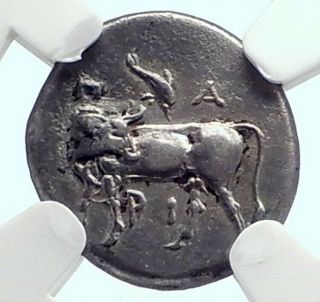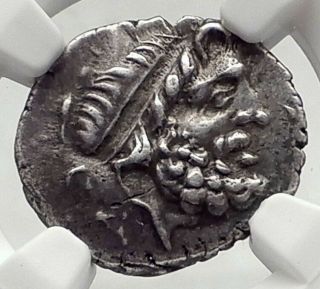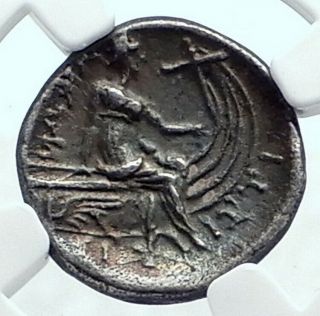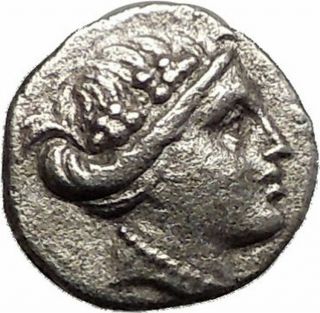BYZANTION In THRACE Authentic Ancient Silver Greek Coin COW DOLPHIN NGC I77487
Item History & Price
Item: i77487
Authentic Ancient Coin of: Greek city of Byzantion in Thrace
Silver Half Siglos or Hemidrachm 14mm Struck circa 340-320 B.C.
Reference: Sear 1582 (Tetrobol); HGC 3.2, 1390; B.M.C. 3.15, 16; SNG Cop. 478
Certification: NGC Ancients VF 4934597-009
Cow standing left, on dolphin left, right foreleg raised; above, ΠΥ.
Incuse square of "mill-sail" pattern.A prosperous city, through its control of the vital grain trade from the Black Se...a, Byzantion was founded by Megarian colonists about 657 B.C., and was besieged by Philip of Macedon, 340/339 B.C.You are bidding on the exact item pictured, provided with a Certificate of Authenticity and Lifetime Guarantee of Authenticity.Byzantium (Greek: Βυζάντιον Byzántion) was the ancient Greek city on the site that later became Constantinople (modern Istanbul). It was founded by Greek colonists from Megara in 657 BC. The city was rebuilt and reinaugurated as the new capital of the Roman Empire by Emperor Constantine I in 330 AD and subsequently renamed Constantinople. The city remained the capital until 1453, when it was conquered and became the capital of the Ottoman Empire. Since the establishment of modern Turkey in 1923, the Turkish name of the city, Istanbul, has replaced the name Constantinople in the West.NameThe etymology of the Greek form Byzantion is unknown. In Greek legend it is said to be named after Byzas, the leader of the Megarean colonists and founder of the city. The name has been suggested as being of Thraco-Illyrian origin, perhaps indeed from a personal name Buzas. The form Byzantium is a Latinization of the Greek.HistoryThe origins of Byzantium are shrouded in legend. The traditional legend has it that Byzas from Megara (a city-state near Athens) founded Byzantium in 657 BC when he sailed northeast across the Aegean Sea. Byzas had consulted the Oracle at Delphi to ask where to found his new city. The Oracle told him to find it "opposite the blind". At the time, he did not know what this meant, but when he came upon the Bosporus he understood: on the opposite eastern shore was a Greek city, Chalcedon, whose founders were said to have overlooked the superior location only 3 kilometres (1.9 mi) away. Byzas founded his city there on the European coast and named it Byzantium after himself. It was mainly a trading city due to its location at the Black Sea's only entrance. Byzantium later conquered Chalcedon, across the Bosporus on the Asiatic side.After siding with Pescennius Niger against the victorious Septimius Severus, the city was besieged by Roman forces and suffered extensive damage in 196 AD. Byzantium was rebuilt by Septimius Severus, now emperor, and quickly regained its previous prosperity. It was bound to Perinthos during the period of Septimius Severus. The location of Byzantium attracted Roman Emperor Constantine I who, in 330 AD, refounded it as an imperial residence inspired by Rome itself. (See Nova Roma.) After his death the city was called Constantinople (Greek Κωνσταντινούπολις or Konstantinoupolis) ("city of Constantine").This combination of imperialism and location would affect Constantinople's role as the nexus between the continents of Europe and Asia. It was a commercial, cultural, and diplomatic centre. With its strategic position, Constantinople controlled the route between Asia and Europe, as well as the passage from the Mediterranean Sea to the Black Sea. On May 29, 1453, the city fell to the Ottoman Turks, and again became the capital of a powerful state, the Ottoman Empire. The Turks called the city "Istanbul" (although it was not officially renamed until 1930); the name derives from "eis-tin-polin" (Greek: "to-the-city"). To this day it remains the largest and most populous city in Turkey (the successor to the Ottoman Empire), although Ankara is now the national capital.EmblemMain article: Star and crescentThough associated with the Sassanid Persians and with Mithradates VI Eupator (who for a time incorporated the city into his empire), by the late Hellenistic or early Roman period, the star and crescent motif had been associated to some degree with Byzantium. For example, some Byzantine coins of the 1st century BC and later show the head of Artemis with bow and quiver, and feature a crescent with what appears to be a six-rayed star on the reverse. According to accounts which vary in some of the details, in 340 BC the Byzantines and their allies the Athenians were under siege by the troops of Philip of Macedon. On a particularly dark and wet night Philip attempted a surprise attack but was thwarted by the appearance of a bright light in the sky. This light is occasionally described by subsequent interpreters as a meteor, sometimes as the moon, and some accounts also mention the barking of dogs. However, the original accounts mention only a light in the sky, without specifying the moon. To commemorate the event the Byzantines erected a statue of Hecate lampadephoros (light-bearer or bringer). This story survived in the works of Hesychius of Miletus, who in all probability lived in the time of Justinian I. His works survive only in fragments preserved in Photius and the tenth century lexicographer Suidas. The tale is also related by Stephanus of Byzantium, and Eustathius.Devotion to Hecate was especially favored by the Byzantines for her aid in having protected them from the incursions of Philip of Macedon. Her symbols were the crescent and star, and the walls of her city were her provenance.It is unclear precisely how the symbol Hecate/Artemis, one of many goddesses would have been transferred to the city itself, but it seems likely to have been an effect of being credited with the intervention against Philip and the subsequent honors. This was a common process in ancient Greece, as in Athens where the city was named after Athena in honor of such an intervention in time of war.Later, under the Romans, cities in the empire often continued to issue their own coinage. "Of the many themes that were used on local coinage, celestial and astral symbols often appeared, mostly stars or crescent moons." The wide variety of these issues, and the varying explanations for the significance of the star and crescent on Roman coinage precludes their discussion here. It is, however, apparent that by the time of the Romans, coins featuring a star or crescent in some combination were not at all rare.Notable peopleHomerus, tragedian, lived in the early 3rd century BCPhilo, engineer, lived ca. 280 BC-ca. 220 BCEpigenes of Byzantium, astrologer, lived in the 3rd-2nd century BCAristophanes of Byzantium, a scholar who flourished in Alexandria, 3rd-2nd century BCSee alsoConstantinople details the history of the city before the Turkish conquest of 1453.Istanbul details the history of the city from 1453 on, and describes the modern city.Sarayburnu is the geographic location of ancient Byzantium.Timeline of Istanbul historyFrequently Asked Questions
Mr. Ilya Zlobin, world-renowned expert numismatist, enthusiast, author and dealer in authentic ancient Greek, ancient Roman, ancient Byzantine, world coins & more.Who am I dealing with?You are dealing with Ilya Zlobin, ancient coin expert, enthusiast, author and dealer with an online store having a selection of over 15, 000 items with great positive feedback from verified buyers and over 10 years experience dealing with over 57, 000 ancient and world coins and artifacts. Ilya Zlobin is an independent individual who has a passion for coin collecting, research and understanding the importance of the historical context and significance all coins and objects represent. Most others are only concerned with selling you, Ilya Zlobin is most interested in educating you on the subject, and providing the largest selection, most professional presentation and service for the best long-term value for collectors worldwide creating returning patrons sharing in the passion of ancient and world coin collecting for a lifetime. How long until my order is shipped?Orders are shipped by the next business day (after receipt of payment) most of the time. How will I know when the order was shipped?After your order has shipped, you will be left positive feedback, and that date could be used as a basis of estimating an arrival date. Any tracking number would be found under your 'Purchase history' tab.USPS First Class mail takes about 3-5 business days to arrive in the U.S. International shipping times cannot be estimated as they vary from country to country.Standard international mail to many countries does not include a tracking number, and can also be slow sometimes. For a tracking number and signature confirmation, you may want to do Express Mail International Shipping, which costs more, however, is the fastest and most secure. Additionally you may be able to receive your order in as little as 3-5 business days using this method. For Express Mail International, it may be possible to place up to 10-15 items in one package (for the one shipping cost) as it is flat rate envelope, which may be the most cost-effective, secure and fastest way to receive items internationally. Send me a message about this and I can update your invoice should you want this method.Getting your order to you, quickly and securely is a top priority and is taken seriously here. Great care is taken in packaging and mailing every item securely and quickly.Please be aware, I cannot take responsibility for any postal service delivery delays, especially for international packages as it may happen in rare instances.What is a certificate of authenticity and what guarantees do you give that the item is authentic?Each of the items sold here, is provided with a Certificate of Authenticity, and a Lifetime Guarantee of Authenticity, issued by a world-renowned numismatic and antique expert that has identified over 57, 000 ancient coins and has provided them with the same guarantee. You will be very happy with what you get with the COA; a professional presentation of the coin, with all of the relevant information and a picture of the coin you saw in the listing. Additionally, the coin is inside it's own protective coin flip (holder), with a 2x2 inch description of the coin matching the individual number on the COA.On the free-market such a presentation alone, can be considered a $25-$50 value all in itself, and it comes standard with your purchases from me, FREE. With every purchase, you are leveraging my many years of experience to get a more complete context and understanding of the piece of history you are getting. Whether your goal is to collect or give the item as a gift, coins presented like this could be more prized and valued higher than items that were not given such care and attention to.Buy a coin today and own a piece of history, guaranteed.Is there a money back guarantee?I offer a 30 day unconditional money back guarantee. I stand behind my coins and would be willing to exchange your order for either store credit towards other coins, or refund, minus shipping expenses, within 30 days from the receipt of your order. My goal is to have the returning customers for a lifetime, and I am so sure in my coins, their authenticity, numismatic value and beauty, I can offer such a guarantee.When should I leave feedback?Once you receive your order, please leave a positive feedback. Please don't leave any negative feedbacks, as it happens sometimes that people rush to leave feedback before letting sufficient time for their order to arrive. Also, if you sent an email, make sure to check for my reply in your messages before claiming that you didn't receive a response. The matter of fact is that any issues can be resolved, as reputation is most important to me. My goal is to provide superior products and quality of service.How and where do I learn more about collecting ancient coins?Visit the "Guide on How to Use My Store" for on an overview about using my store, with additional information and links to all other parts of my store which may include educational information on topics you are looking for.
05682
Authentic Ancient Coin of: Greek city of Byzantion in Thrace
Silver Half Siglos or Hemidrachm 14mm Struck circa 340-320 B.C.
Reference: Sear 1582 (Tetrobol); HGC 3.2, 1390; B.M.C. 3.15, 16; SNG Cop. 478
Certification: NGC Ancients VF 4934597-009
Cow standing left, on dolphin left, right foreleg raised; above, ΠΥ.
Incuse square of "mill-sail" pattern.A prosperous city, through its control of the vital grain trade from the Black Se...a, Byzantion was founded by Megarian colonists about 657 B.C., and was besieged by Philip of Macedon, 340/339 B.C.You are bidding on the exact item pictured, provided with a Certificate of Authenticity and Lifetime Guarantee of Authenticity.Byzantium (Greek: Βυζάντιον Byzántion) was the ancient Greek city on the site that later became Constantinople (modern Istanbul). It was founded by Greek colonists from Megara in 657 BC. The city was rebuilt and reinaugurated as the new capital of the Roman Empire by Emperor Constantine I in 330 AD and subsequently renamed Constantinople. The city remained the capital until 1453, when it was conquered and became the capital of the Ottoman Empire. Since the establishment of modern Turkey in 1923, the Turkish name of the city, Istanbul, has replaced the name Constantinople in the West.NameThe etymology of the Greek form Byzantion is unknown. In Greek legend it is said to be named after Byzas, the leader of the Megarean colonists and founder of the city. The name has been suggested as being of Thraco-Illyrian origin, perhaps indeed from a personal name Buzas. The form Byzantium is a Latinization of the Greek.HistoryThe origins of Byzantium are shrouded in legend. The traditional legend has it that Byzas from Megara (a city-state near Athens) founded Byzantium in 657 BC when he sailed northeast across the Aegean Sea. Byzas had consulted the Oracle at Delphi to ask where to found his new city. The Oracle told him to find it "opposite the blind". At the time, he did not know what this meant, but when he came upon the Bosporus he understood: on the opposite eastern shore was a Greek city, Chalcedon, whose founders were said to have overlooked the superior location only 3 kilometres (1.9 mi) away. Byzas founded his city there on the European coast and named it Byzantium after himself. It was mainly a trading city due to its location at the Black Sea's only entrance. Byzantium later conquered Chalcedon, across the Bosporus on the Asiatic side.After siding with Pescennius Niger against the victorious Septimius Severus, the city was besieged by Roman forces and suffered extensive damage in 196 AD. Byzantium was rebuilt by Septimius Severus, now emperor, and quickly regained its previous prosperity. It was bound to Perinthos during the period of Septimius Severus. The location of Byzantium attracted Roman Emperor Constantine I who, in 330 AD, refounded it as an imperial residence inspired by Rome itself. (See Nova Roma.) After his death the city was called Constantinople (Greek Κωνσταντινούπολις or Konstantinoupolis) ("city of Constantine").This combination of imperialism and location would affect Constantinople's role as the nexus between the continents of Europe and Asia. It was a commercial, cultural, and diplomatic centre. With its strategic position, Constantinople controlled the route between Asia and Europe, as well as the passage from the Mediterranean Sea to the Black Sea. On May 29, 1453, the city fell to the Ottoman Turks, and again became the capital of a powerful state, the Ottoman Empire. The Turks called the city "Istanbul" (although it was not officially renamed until 1930); the name derives from "eis-tin-polin" (Greek: "to-the-city"). To this day it remains the largest and most populous city in Turkey (the successor to the Ottoman Empire), although Ankara is now the national capital.EmblemMain article: Star and crescentThough associated with the Sassanid Persians and with Mithradates VI Eupator (who for a time incorporated the city into his empire), by the late Hellenistic or early Roman period, the star and crescent motif had been associated to some degree with Byzantium. For example, some Byzantine coins of the 1st century BC and later show the head of Artemis with bow and quiver, and feature a crescent with what appears to be a six-rayed star on the reverse. According to accounts which vary in some of the details, in 340 BC the Byzantines and their allies the Athenians were under siege by the troops of Philip of Macedon. On a particularly dark and wet night Philip attempted a surprise attack but was thwarted by the appearance of a bright light in the sky. This light is occasionally described by subsequent interpreters as a meteor, sometimes as the moon, and some accounts also mention the barking of dogs. However, the original accounts mention only a light in the sky, without specifying the moon. To commemorate the event the Byzantines erected a statue of Hecate lampadephoros (light-bearer or bringer). This story survived in the works of Hesychius of Miletus, who in all probability lived in the time of Justinian I. His works survive only in fragments preserved in Photius and the tenth century lexicographer Suidas. The tale is also related by Stephanus of Byzantium, and Eustathius.Devotion to Hecate was especially favored by the Byzantines for her aid in having protected them from the incursions of Philip of Macedon. Her symbols were the crescent and star, and the walls of her city were her provenance.It is unclear precisely how the symbol Hecate/Artemis, one of many goddesses would have been transferred to the city itself, but it seems likely to have been an effect of being credited with the intervention against Philip and the subsequent honors. This was a common process in ancient Greece, as in Athens where the city was named after Athena in honor of such an intervention in time of war.Later, under the Romans, cities in the empire often continued to issue their own coinage. "Of the many themes that were used on local coinage, celestial and astral symbols often appeared, mostly stars or crescent moons." The wide variety of these issues, and the varying explanations for the significance of the star and crescent on Roman coinage precludes their discussion here. It is, however, apparent that by the time of the Romans, coins featuring a star or crescent in some combination were not at all rare.Notable peopleHomerus, tragedian, lived in the early 3rd century BCPhilo, engineer, lived ca. 280 BC-ca. 220 BCEpigenes of Byzantium, astrologer, lived in the 3rd-2nd century BCAristophanes of Byzantium, a scholar who flourished in Alexandria, 3rd-2nd century BCSee alsoConstantinople details the history of the city before the Turkish conquest of 1453.Istanbul details the history of the city from 1453 on, and describes the modern city.Sarayburnu is the geographic location of ancient Byzantium.Timeline of Istanbul historyFrequently Asked Questions
Mr. Ilya Zlobin, world-renowned expert numismatist, enthusiast, author and dealer in authentic ancient Greek, ancient Roman, ancient Byzantine, world coins & more.Who am I dealing with?You are dealing with Ilya Zlobin, ancient coin expert, enthusiast, author and dealer with an online store having a selection of over 15, 000 items with great positive feedback from verified buyers and over 10 years experience dealing with over 57, 000 ancient and world coins and artifacts. Ilya Zlobin is an independent individual who has a passion for coin collecting, research and understanding the importance of the historical context and significance all coins and objects represent. Most others are only concerned with selling you, Ilya Zlobin is most interested in educating you on the subject, and providing the largest selection, most professional presentation and service for the best long-term value for collectors worldwide creating returning patrons sharing in the passion of ancient and world coin collecting for a lifetime. How long until my order is shipped?Orders are shipped by the next business day (after receipt of payment) most of the time. How will I know when the order was shipped?After your order has shipped, you will be left positive feedback, and that date could be used as a basis of estimating an arrival date. Any tracking number would be found under your 'Purchase history' tab.USPS First Class mail takes about 3-5 business days to arrive in the U.S. International shipping times cannot be estimated as they vary from country to country.Standard international mail to many countries does not include a tracking number, and can also be slow sometimes. For a tracking number and signature confirmation, you may want to do Express Mail International Shipping, which costs more, however, is the fastest and most secure. Additionally you may be able to receive your order in as little as 3-5 business days using this method. For Express Mail International, it may be possible to place up to 10-15 items in one package (for the one shipping cost) as it is flat rate envelope, which may be the most cost-effective, secure and fastest way to receive items internationally. Send me a message about this and I can update your invoice should you want this method.Getting your order to you, quickly and securely is a top priority and is taken seriously here. Great care is taken in packaging and mailing every item securely and quickly.Please be aware, I cannot take responsibility for any postal service delivery delays, especially for international packages as it may happen in rare instances.What is a certificate of authenticity and what guarantees do you give that the item is authentic?Each of the items sold here, is provided with a Certificate of Authenticity, and a Lifetime Guarantee of Authenticity, issued by a world-renowned numismatic and antique expert that has identified over 57, 000 ancient coins and has provided them with the same guarantee. You will be very happy with what you get with the COA; a professional presentation of the coin, with all of the relevant information and a picture of the coin you saw in the listing. Additionally, the coin is inside it's own protective coin flip (holder), with a 2x2 inch description of the coin matching the individual number on the COA.On the free-market such a presentation alone, can be considered a $25-$50 value all in itself, and it comes standard with your purchases from me, FREE. With every purchase, you are leveraging my many years of experience to get a more complete context and understanding of the piece of history you are getting. Whether your goal is to collect or give the item as a gift, coins presented like this could be more prized and valued higher than items that were not given such care and attention to.Buy a coin today and own a piece of history, guaranteed.Is there a money back guarantee?I offer a 30 day unconditional money back guarantee. I stand behind my coins and would be willing to exchange your order for either store credit towards other coins, or refund, minus shipping expenses, within 30 days from the receipt of your order. My goal is to have the returning customers for a lifetime, and I am so sure in my coins, their authenticity, numismatic value and beauty, I can offer such a guarantee.When should I leave feedback?Once you receive your order, please leave a positive feedback. Please don't leave any negative feedbacks, as it happens sometimes that people rush to leave feedback before letting sufficient time for their order to arrive. Also, if you sent an email, make sure to check for my reply in your messages before claiming that you didn't receive a response. The matter of fact is that any issues can be resolved, as reputation is most important to me. My goal is to provide superior products and quality of service.How and where do I learn more about collecting ancient coins?Visit the "Guide on How to Use My Store" for on an overview about using my store, with additional information and links to all other parts of my store which may include educational information on topics you are looking for.
05682




